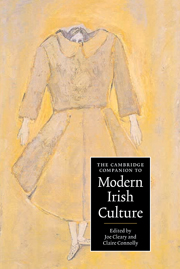Book contents
- Frontmatter
- 1 Introduction: Ireland and modernity
- Part I Cultural politics
- Part II Cultural practices and cultural forms
- 9 Modernism and the Irish revival
- 10 Poetry in Ireland
- 11 Irish sport
- 12 Projecting the nation: cinema and culture
- 13 Folk culture
- 14 Irish prose fiction
- 15 Irish music
- 16 Modern architecture and national identity in Ireland
- 17 The visual arts in Ireland
- 18 Irish theatre
- Index
16 - Modern architecture and national identity in Ireland
from Part II - Cultural practices and cultural forms
Published online by Cambridge University Press: 28 May 2006
- Frontmatter
- 1 Introduction: Ireland and modernity
- Part I Cultural politics
- Part II Cultural practices and cultural forms
- 9 Modernism and the Irish revival
- 10 Poetry in Ireland
- 11 Irish sport
- 12 Projecting the nation: cinema and culture
- 13 Folk culture
- 14 Irish prose fiction
- 15 Irish music
- 16 Modern architecture and national identity in Ireland
- 17 The visual arts in Ireland
- 18 Irish theatre
- Index
Summary
Nationalism and modernism: the twin imperatives
In 1939, the Irish architect Michael Scott brought his design for an Irish Pavilion to the New York World's Fair: 'A board of ten or twelve architects vetted every building for the World's Fair. I appeared before them with the model and explained the whole idea behind it. They thought it was marvellous, a wonderful building. They liked how I solved the problem of nationalism and made it modern at the same time.' To the visitor the pavilion initially appeared as a sleek and sinuous form clad in concrete and glass, with a bright, airy interior (Fig. 16.1). Only from the air would it become clear that the building had a shamrock-shaped plan. If this device now seems somewhat corny or superficial, the challenge facing Scott - that of reconciling the imperatives of nationalism and of modernism within a single representative form - was evidently a substantial and enduring one. Indeed it seems possible to discuss the architecture of Ireland's modern era precisely in terms of this tension between the desire to be modern and the requirement to be representative of some idea of the 'national spirit'.
While this tension sometimes became the subject of deliberate theories and projects (as with Scott’s pavilion), more often it simply formed the cultural climate within which Irish architecture was produced. Sometimes the two forces effectively cancelled each other out, resulting in architecture which was neither particularly modern nor particularly Irish. But at other times an architecture emerged which seemed, almost effortlessly, to be as much of its place as of its time.
- Type
- Chapter
- Information
- The Cambridge Companion to Modern Irish Culture , pp. 285 - 303Publisher: Cambridge University PressPrint publication year: 2005



